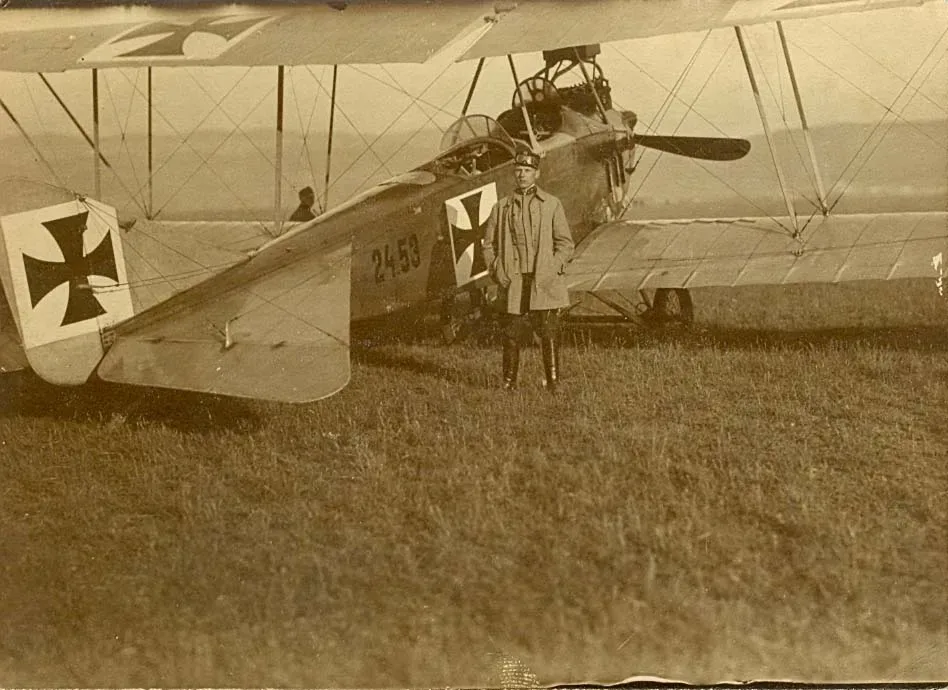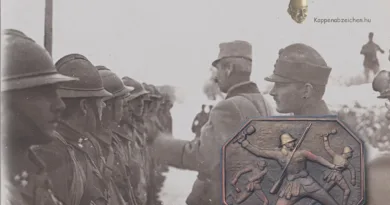Hansa-Brandenburg C-I aircraft
There were several types of aircraft-related Kappenabzeichen. The pilots’ qualification badges were, of course different, they were awarded, made in fine quality, and they are rare to find. These simple badges were sold to anyone interested. The aircraft on the badge (Hansa Brandenburg CI) was the plane of Captain Adolf Heyrowski according to the side number (29+64).

This aircraft type was the monarchy’s most important two-seater reconnaissance plane. It was manufactured in Vienna and Aszód under German license (446 and 732 pieces respectively). It was most often equipped with a 200 hp Daimler engine performing a top speed of 134 km/h. The plane climbed to 1,000 meters in five minutes. It was armed with a rear-firing 8mm Schwrzlose machine gun. It was also capable of bombing. Some of the planes also had pre-firing machine guns on top of the wing.

The plane was normally piloted by an NCO pilot, under the command of the observer officer. The observer photographed, took notes and handled the defensive machine gun firing backwards. In air combat, it must have been more sluggish than single-seater fighter planes. Perhaps that’s why Captain Heyrowski gained so much attention as a pilot, since he scored several air victories with this type. Adolf Heyrowski’s career received a lot of attention, so he had a propaganda value in the Monarchy. With 12 confirmed air victories, he was the 10th most successful fighter pilot of the Monarchy.

His story can be found in the 46th booklet of the Osprey Aircraft of the Aces series, which is about the Austro-Hungarian Air Force. The accompanying sketch also shows Heyrowski’s 29+64 Phönix Hansa-Brandenburg CI. The badge depicts exactly this aircraft, the distinctive tail part of the type is clearly visible on the badge, and badges in slightly better condition even show the side number of the plane!

Why did this machine chosen for the badge? We can get the answer from the Osprey book. Heyrowski has scored 11 of his 12 victories as a pilot of the two-seater reconnaissance plane depicted. That’s why his performance is so special. Heyrowski was commander of the 12th Squadron from August 1915 and later the 19th Squadron on the Isonzo Front. He shot down 5 enemy planes with this single aircraft. According to the Osprey book, Heyrowski did not fly in 5th and 6th Battles of Isonzo. Instead he served as a squadron commander in the K.u.K. 27th Infantry Regiment! In the summer of 1917 he was promoted to chief of staff, and in March 1918 he was deployed to the Western Front, where he was involved in several bomber missions against British targets. In World War II, he was an officer of the Luftwaffe. In March 1945, at the age of 63, he was flying an Fw 190 when he was shot down by American fighters.





[…] prior to the Great War. The only exception is the Hansa Brandenburg C I, which I wrote about earlier here. Therefore, for this post, I rather uploaded a rare and very nice cap badge from a squadron of […]
[…] after the war ended. The first commander of the squadron was Adolf Heyrowski, who I wrote about here before. The later ace squadron commander achieved two aerial victories as part of this […]